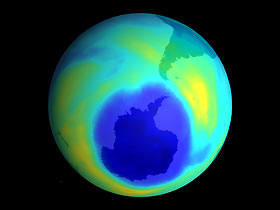
Save this image free of charge
in 800 pixels for layout use
(right click, Save as...)
|
|
Ref : V01053
Theme :
Earth in Space (419 images)
Title : Antarctic Ozone Hole on September 17, 2001
Caption :
Satellite data show the area of this year Antarctic ozone hole peaked at about 26 million square kilometersroughly the size of North Americamaking the hole similar in size to those of the past three years, according to scientists from NASA and the National Oceanic and Atmospheric Administration (NOAA). Researchers have observed a leveling-off of the hole size and predict a slow recovery. Over the past several years the annual ozone hole over Antarctica has remained about the same in both its size and in the thickness of the ozone layer. 'This is consistent with human-produced chlorine compounds that destroy ozone reaching their peak concentrations in the atmosphere, leveling off, and now beginning a very slow decline,' said Samuel Oltmans of NOAA Climate Monitoring and Diagnostics Laboratory, Boulder, Colo. In the near futurebarring unusual events such as explosive volcanic eruptionsthe severity of the ozone hole will likely remain similar to what has been seen in recent years, with year-to-year differences associated with meteorological variability. Over the longer term (30-50 years) the severity of the ozone hole in Antarctica is expected to decrease as chlorine levels in the atmosphere decline. The image above shows ozone levels on Spetember 17, 2001the lowest levels observed this year. Dark blue colors correspond to the thinnest ozone, while light blue, green, and yellow pixels indicate progressively thicker ozone.
|
|

